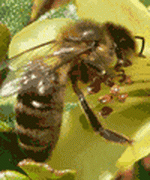
Image from: http://Phys.Org
Not only do bees sting, but they also bite victims that are too small for stingers (ex: wax moth larva that invade the beehive and eat pollen) and paralyze them for up to nine minutes by secreting 2-heptanone into the wound. This paralysis gives the bees time to remove the invaders from the beehive. Dr. Papachristoforou and his team at Aristotle University of Thessaloniki in Greece discovered the paralyzing effects of the honeybee bite while studying wax moth larvae that invade the beehives. Their data suggest that this chemical may be an effective anesthetic for human and animal medical applications. The company that funded the project (Vita) has already patented the use of 2-heptanone as a local anesthetic. Of course clinical studies are now needed to verify the efficacy and safety of this chemical for human and veterinary anesthetic use.
Sources:
Papachristoforou A, Kagiava A, Papaefthimiou C, Termentzi A, Fokialakis N, Skaltsounis A-L, Watkins M, Arnold G, Theophilidis G. The Bite of the Honeybee: 2-Heptanone Secreted from Honeybee Mandibles during a Bite Acts as a Local Anaesthetic in Insects and Mammals. PLoS ONE. 7(10): e47432. doi:10.1371/journal.pone.0047432

interesting.
Wow...didn't knew this fact about Honeybees...Thanks Dr. Dolittle!
gabion baskets